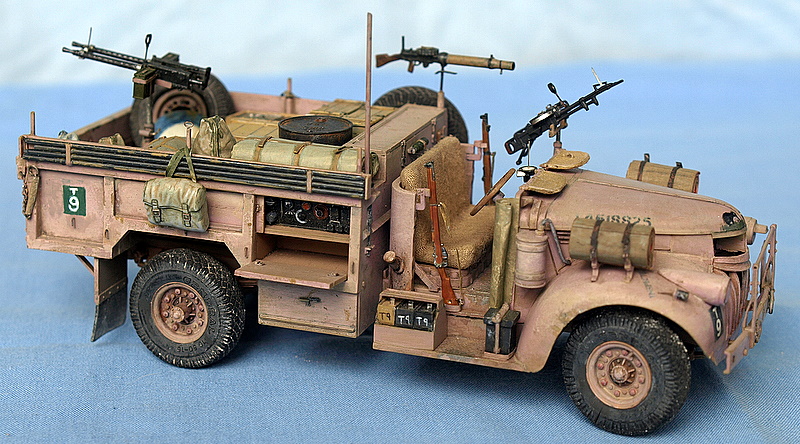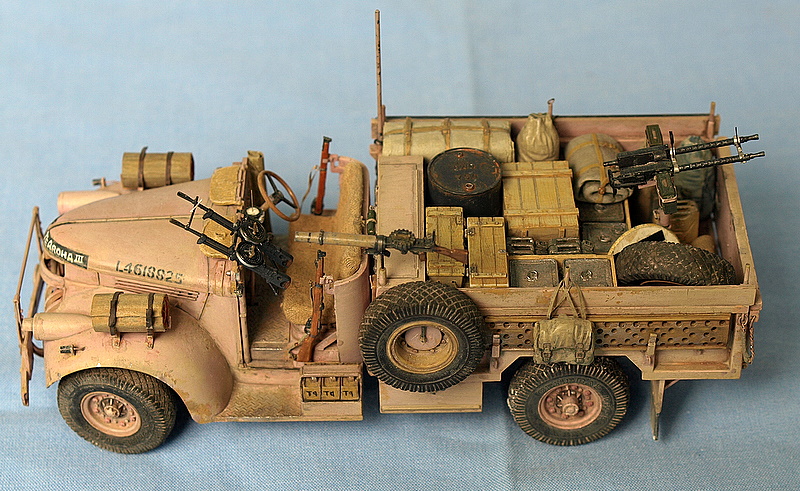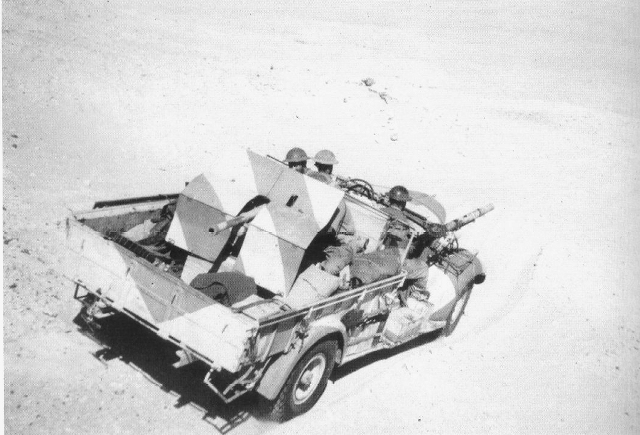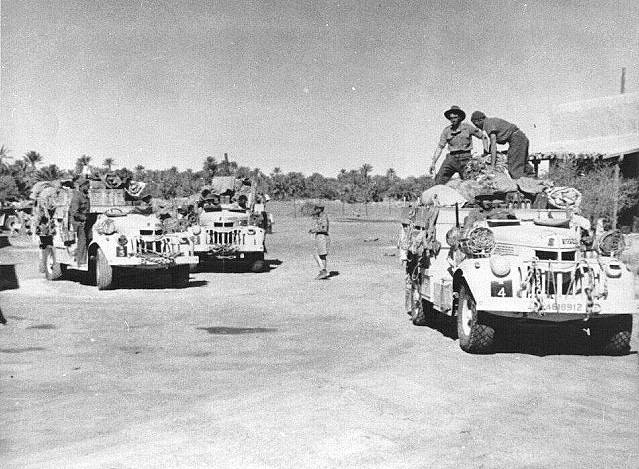Chevrolet WD 30 CWT 1-1/2 tons truck (1940)

 USA/Canada (1940-43). (circa 2,000 built)
USA/Canada (1940-43). (circa 2,000 built)
The LRDG "technical"
The "Chevy 30 CWT" as known universally is instantaneously identified to the LRDG truck, the heavy element of a pair that formed the core of the motorized Long Range Desert Patrol, with the Willys Jeep. But its origins are not that well known. This standardized light truck was indeed only produced in Canada under licence, as part of the larger CMP family ("Canadian pattern").
The origins: CMP trucks
During World War 2, Canadian factories built large numbers of standardised trucks, to be used by Commonwealth armies. That is they are less well known in the general public compared to US trucks. These "Canadian Made" trucks were divided into two main types:
The CMP vehicles (Canadian Military Pattern) tailored for military use
The MCP vehicles (Modified Conventional Pattern), civilian vehicles adopted for military use.
It's among the latter that was found the
Chevrolet 1533x2 1.5-ton 4x2 truck, most famously used by the Long Range Desert Group (LRDG) of the British Army.
Creation and short history of the LRDG
The famous "Long Range Desert Group" is such a legendary unit of WW2. It is largely seen as a forefunner of the SAS (British Special Air Service) one of the first "speco-ops" or special operation unit. Alongside the Commandos, these men formed a "special breed" and were largely seen as an elite force, precious assets to be sent in dangerous and vital operations. In the case of the LRDG, it was called at first the "Long Range Patrol" (LRP), founded in Egypt in June 1940 by Major
Ralph Alger Bagnold under the direction of General Archibald Wavell.
Bagnold, a colorful caracter not keen on authority, looked for strong caracters to form his motorized reconnaissance unit, as the front grew static in North Africa. He soon was assisted by Captain Patrick Clayton and Captain William Shaw. His idea was to break the deadlock of operations by undermining the enemy rear lines, making deep forays with swift columns of light vehicles. Mobility was key, but these vehicles were all heavily armed, not counter any threats on the way, and attack specifi objectives deep into enemy territory, mostly support bases, depots, ralways junctions or airfields.
The first men hired from the task were from New Zealand, soon joined by Southern Rhodesian, British volunteers, and soon enough men and vehicles were collected to form several sub-units called "patrols" while the expanded unit was renamed Long Range Desert Group (LRDG). At its peak in late 1942, before the second battle of El Alamein, the LRDG totalled than 350 picked-up volunteers and a hundred vehicles. The LRDG was used to deep penetration and covert reconnaissance patrols, intelligence gathering, mostly in the Italian-controlle area. Although it was after the war associated with daring raids on airfields, combat operations were rare.
Because the LRDG became experts in desert navigation and became the facto scouts for other units, such as the Special Air Service and secret agents. First operations started in December 1940 and went on until April 1943, constantly behind enemy lines. The most prominent operation was
Operation Caravan (see later) an attack on Barce airfield, on 13-14 September 1942. They also played a vital role in operation "Road Watch" monitoring traffic from Tripoli to Benghazi, invaluable information transmitted to the British HQ.
Aftee the surrender of the Axis in Tunisia by May 1943, the LRDG expanded operations on the eastern Mediterranean, Greek islands, Italy and Balkans against Italian and German forces of occupation. In 1945 they were poised to be sent to the Far East to wage similar missions against the Japanese Empire but this was eventually cancelled in August. The vehicles were ill-adapted to jingle warfare anyway.
As for vehicles used, it was not limited to the Jeep and Chevy 30 CWT: The Ford F30 CMP (30 CWT) was also used. The Ford F30, a four wheel drive truck designed to replace the commercial Chevrolet 30 CWTs and more "military-like", rugged and simplified models were used. However commonality of parts with the Ford Pilot Cars helped the supply chain, but it came as heavier than Chevrolets, casusing it to fall behind in patrol, or slow them out. It had a 4-speed Flathead V8 running at 6 miles per gallon, and thus, it was replaced when possible by the 30 CWT. It was a great standard among all British Ford CMPs and when on patrol, the hood was stripped off for better cooling. It was also given a purpose built bed and often acted as a heavier portee, to bring artillery support to the patrol. Although still popular and often seen at the start of the LRDG, its gargantuan fuel consumption and weight put it as a second-choice.
The LRDG Chevy 30 CWT
 Two early Chevrolet trucks – CMP left and 'Modified Conventional Pattern' on right, 1942.
Two early Chevrolet trucks – CMP left and 'Modified Conventional Pattern' on right, 1942.
Although the off-road caracteristics and speed of the Jeep was good, for long missions, storage and fuel,the complement of a truck was needed. A unit only formed with Jeeps would have not been that useful, after early forays were made. It was recoignised that the adjunction of a truck with equally solid off-road capabilities, and top of all, endurance and payload, was necessary. There were not so much to choose here. The CMPs being exlusively used in Canadian infantry trained for the frontline (and used mostly in italy later, then in Normandy), early subsidiary units in North Afica hand to make due with the remaining MCP vehicles, of which there was a single, really suitable candidate: The Canadian-built 30 CWT truck, in the nomenclature class Chevrolet C30 (4x4, 134 inch wheelbase, so 30 cwt).
First model 30 CWT
The first trucks locally procured 1 ½ ton Chevrolets proved successful at first. Typical of peacetime production which were designed with streamined features, with its typical horizontal grill and round fenders on the rear wheels, they had left hand steering and were generally armed with a Lewis Gun on a Lewis gun on a Swan Neck mount and a Vickers Maxim on the center pintle, or in alternative, a Boys AT rifle in case of "bad encounter". The latter could deal with most Italian or axis light armored vehicles encountered. However on each patrol a single truck carried a Bofors 40 mm QF anti-tank gun to have an organic capability against tanks.
Any Chevy WB carries also supplies for the patrol, food, water, fuel, and ammunition. Due to the nature of these raids, the prime personal weapon in addition of the rest, and grenades, were at leats one or two Thompson submachine guns (TSMG) always at hand in the cab. The 30 CWT was stripped bare, without doors, the windshield folded down, and often unditching perforating ramps strapped onto the flatbed's walls.
Specs: 216 CI 6 Cylinder inline engine with 4 forward x 1 reverse gearbox, Left Hand steering, 20 gallon tank @240 Miles. Chassis 134 inches with 10.50 X 16 tyres. Payload: 3,000 pounds.
Early Ford 01 Pilot Car (15 CWT)
The First Pilot (Commander's) Car was generally a 1940/41 Ford 01 Pick-up truck, rated either at ½ or ¾ tons with a 114 inches wheelbase and caracterized by its front "V" grill, large black teardrop engine bonnet, cut out for better cooling. New rear fenders for easy access to the tires were procured and swan neck pintles for a large variery of machine guns. Fords kept their doors for only a time. They were removed like the others, wheras a wooden structure was often built above the flatbed with extra storage bins affixed to it. In standard they carried a Vickers .303 MG or Lewis Gun, and sometimes both, plus personal weapons, most of the time Lee-enfield rifles and revolvers, plus a crate of grenades. The pilot car navigated the whole column in the desert and choose the best terrain to advance.
specs 221 CI Ford/Mercury Flathead V8 cylinder with 4 fwd/1 reverse speeds, left hand steering and 16 Gal. fuel tank. Useful payload 1,500 Ibs.
Chevrolet 1533X2 30 CWT

 Model of the Chevy LRDG 1533x2
Model of the Chevy LRDG 1533x2
The final, mature patrol truck, which was really the best and most common LRDG "heavy mount". This was the ulltimate all around Patrol Truck, two wheel drive and completely modified in Canada and later in local workshops with scores of military modifications. The base vehicle with its typical "water fall" grill was called in the US
1½ ton YR serie Chevrolet. These "factory" modifications included:
-Special truck bed
-New cab
-Reworked front grill for better cooling
-Strenghtened suspensions.
Further modifications were made in LRDG workships in Cairo:
-Right hand drive.
-New Grill with fewer slats for better air flow.
These vehicles were also used a support "technical", the name given to heavily armed pickups with generally an AA, rapid-fire gun on the flatbed. The early vehicles had a 1st gen.
37 mm antitank Bofors gun but it was replaced gradually by the Italian Model 35 Breda 20 mm AA gun, as soon as they were captured (dozens were so during Operation Compass back in 1940). In a column one on six trucks had a Breda and another was a radio truck. But a command car could also tow a Breda. Towing guns was however quite rare in patrol. But they also carried other cannons, anti-tank, a better proposition than the usual Boys cal.50 rifle: The 2-Pdr QF Portee was a dedicated antitank variant, more potent than the Bofors and often used alongside another Breda Truck, the latter used more for organic AA.
 Chevy with Bofors AT gun
Chevy with Bofors AT gun
Rge other Chevy truks war optimized to carry supplies and fuel cans. They were more lightlu armed, with a Vickers .5 inch heavy machine gun on the flatbed, a Vickers GO (or Vickers K) light machine gun forward, manned by the the passenger. The Vickers .5 inch was replaced by the ANM2 Browning when possible, as it was water-cooled and not that powerful, but it was reliable. Those vehicles were sometimes used also to resupply lines for Allied troops. The two wheel drive, were lighter, more fuel efficient than four wheel drive vehicles, and stripped bare:
The first thing workshops did was to remove doors, windscreens and roofs. A larger radiator was fitted when possible, all openings were widened and extra ones created when practicable, but an new condenser system was installed as well as thicker (or just with extra layers) leaf springs. The tyres were wide, low pressure desert tyres ideal to offer the best grip. They also had sand mats and channels installed aft, and for navigation map containers and a sun compass. The radio vehicles had a special built-in compartment to house the emitter/receptor.
| Specs Chevy 1533X2 30 CWT |
| Dimensions : | Wheelbase 134 in |
| Total weight, battle ready : | circa 4 tons |
| Tires : | 10.50X20 |
| Crew : | 2 |
| Propulsion: | 216 or 235 CI Chevy in-line 6 cylinder* |
| Speed : | 50 km/h (30 mph) |
| Range (road/off road) : | 240 Miles, 20 gal. tank |
| Payload : | 3,000 pounds |
| Production | Circa 400 |
*In 1941, Chevrolet introduced a 235.5-cubic-inch version of their 216 engine which was used in their large trucks such as the 1-½ tonners. Both the bore (3.5625” or 90.49mm) and stroke (3.9375” or 100.01mm) were increased over the old 216.
LRDG Chevy in Action
Initially LRDG patrols has a single 4WD CMP Ford 15cwt F15 truck used solely by the commander, the rest being given up to ten Chevrolet 30cwt wide-body (WB) trucks. But from March 1941 these Chevrolets were swapped for CMP Ford 30cwt F30, heavier four wheel drive which reduced patrol range. From March 1942, some 200 Canadian-built Chevrolet 1533x2 30cwts specially ordered for the LRDG arrived, and received in Cairo further modifications. From July 1942 also, LRDG obtained Willys Jeeps, at first only issued to the patrol commander and patrol sergeant. By late 1942, the typical patrol comprised one Jeep, 6-7 Chevy trucks with one radio vehicle, one or two cannon vehicles, the rest being machine-gun armed, notably with US-leased M1919 A4 light MGs and the usual Browning M1920 on the flatbed, usable as AA defence.
Operations in North Africa (Dec. 1940-May 1943)
 Area of Operation
Area of Operation
First Operations (Sept-Dec. 1940)
'W' Patrol commanded by Captain Mitford made the first large foray on 15 September 1940, a reconnaissance of Kufra and Uweinat. Not finding the Italians, the columns started to attack secondary objectives, notably fuel and water depots. He was joined by 'T' Patrol (Captain Clayton). On 27 December 1940, 'G' and 'T' Patrols crossed the desert to northwest of Kufra, later to be met by Free French representatives looking also for an action on Kufra, this led to a major and succesful raid (see below).
Attack on Koufra (Jan-March 1941)
One of the first deep penetration of the LRDG was during the attack on Koufra, the first major raid of the Free French Forces led by Col. D'Ornano and later Leclerc (which became quite famous afterwards). The brigade was 350 men strong but had little vehicles to go with. Major Pat Clayton of the LRDG was keen to join this expedition to test the Italians, commanding G Guard and T Patrol of New Zealander with 76 men in 26 vehicles. Most of which were Chevrolet 2WD 30cwt vehicles. At first the raid devastated the Italian airfield at Murzuk, and Leclerc reorganized his forces, gathering extra vehicles to create a column of 400 men in sixty trucks, including two armoured
Laffly S15 TOE scout cars, four
Laffly S15R personnel carriers towing two 75 mm (2.95 in) mountain guns, one of which will play a crucial role to submit the fort. However prior to this, the LRDG tasked to deal with the Italian Saharian company at El Tag was defeated. The Italians had air support, one AS37 and four FIAT 634 lorries. The French later were attacked by another column from Koufra, with seventy men on ten AS37 and five trucks, carrying 20 mm Breda guns which made crippling damage, but he laid siege to the fort with a single field gun and mortars, and it eventually capitulated. The burning souvenir left by the 20 mm Breda led the LRDG to capture and adopt it when available to mount on the Chevrolet 30 cwt.
Post-Compass Operations from Kufra
After
Operation Compass Cyrenaica fell to the allies and it was decided to move the LRDG from Cairo to Kufra in South East Libya while the LRDG was expanded: 'Y' and 'S' Patrols where created; However the German Afrika Korps under General Erwin Rommel arrived and soon counterattacked on April 1941. The LRDG reinforced the Kufra area, 'R' Patrol from Taiserbo, 'S' Patrol from Zighen, and the HQ, 'T' Patrol, and Free French in Kufra under command of Bagnold. G' and 'Y' were sent to Siwa Oasis for the XIII Corps. Major Guy Lenox Prendergast soon created an air component for reconnaissance and liaison, linking to GHQ Cairo with two Waco aircraft, flying one himself, the other by R. F. T. Barker. Bagnold was recalled at the General Staff in Cairo by August 1941 and replaced by Prendergast.
The LRDG Moves to Siwa and Jalo
 R1 Patrol, 30 cwt 1533x2 at Jalo Oasis, Libya 1942
R1 Patrol, 30 cwt 1533x2 at Jalo Oasis, Libya 1942
LRDG patrols behind Axis lines multiplied from there. By late July 1941, 'T' Patrol forayed in the south of the Gulf of Sirte, monitoring Axis traffic, 'S' Patrol went between Jalo oasis and Agedabia and in August 1941 'R' Patrol replaced 'G'-'Y' Patrols at Siwa. From November 1941 the LRDG fell under supervision of the 8th Army and was relocated in Siwa, central Libya. Patrols were sent to the south of Jebel Akhdar and SAS were deployed to raid airfields west of Tobruk. Their role of "SAS Taxis" went on until they got their own transport in 1942. They contributed to Operation Flipper, the planned assassination of Rommel.
 Commendo Force B, Operation Agreement, Tobruk, Sept. 1942
Commendo Force B, Operation Agreement, Tobruk, Sept. 1942
On 24 November the LRDG intervened in support of
Operation Crusader, attacking the axis rear.'Y1' and 'Y2' attacked Mechili, Derna and Gazala; 'S2' and 'R2' conventrated around Benghazi, Barce and Marawa, 'G1' and 'G2' surveyed the main road near Agedabia and attacked road traffic until the Axis forces withdrew from Cyrenaica; The LRDG was moved again to Jalo oasis, 140 miles (230 km) SSE of Ajdabiya. Last operations of 1941 saw in December combined SAS raids on Axis airfields at Sirte, El Agheila, Ajdabiya, Nofaliya and Tamit. In all they claimed 151 aircraft and 30 vehicles.
Road Watch
from Siwa, the LRDG proceeded to 'Road Watch' operartions along the Via Balbia (Tripoli-Benghazi) with three patrols always on watch, rotating every 10 days. They were parked 2 miles away from the road, trucks camouflaged using camouflage nets, foliage and sand and men crawling into an advanced camouflaged positions 350 yards (320 m) from the road. At night they crawled to just 30 yards (27 m) from the road. Valuable assets were communicated to the LRDG headquarters at Siwa, then GHQ Cairo. There were some close encounters. After the Battle of Gazala, fall of Tobruk, the LRDG left Siwa to Cairo and Kufra or Faiyum.
Raid on Barce
One of the most famous raid of the LRDG: The 8th Army hold the El Alamein line, and so it was planned to severe Axis supply lines from Benghazi and Tobruk. In September 1942, Commandos were tasked to attack Tobruk (Operation Agreement) and the SAS Benghazi (Operation Bigamy). The Sudan Defence Force would capture Jalo oasis (Operation Nicety), the LRDG guiding them and carying them in the desert. But one LRDG force would attack Barce (Operation Caravan). This was a force of 17 vehicles (47 men), 'G1' and 'T1' Patrols launched across 1,155 miles (1,859 km). On arrival 'T1' attacked the airfield, 'G1' the barracks in Barce. The Italian lost 16 aircraft, 7 more badly damaged. On 30 September 1942, the LRDG passed onto control of GHQ Middle East and took part in the Mareth Line Offensive, guiding the 2nd New Zealand Division by March 1943.
Italy and Balkans
In May 1943 the LRDG was retrained in mountain warfare in Lebanon and after the Italian armistice they were instead sent to Leros (Dodecanese) dismounted (as regular infantry), taking part in the Battle of Leros. The last New Zealanders veterans (2 officers, 46 men) left the LRDG for the NZ division. By December 1943, the LRDG consisted in two squadrons of eight patrols, with a British one (Major Moir Stormonth Darling) and a Rhodesian one (Major Kenneth Henry Lazarus), parachuted north of Rome to monitor German troop movements and raiding the Dalmatian Islands and Corfu. In August 1944, the British Squadron was parachuted in Yugoslavia and Albania in September 1944, then by October 1944, the Florina area, Greece. Leaders of the LRDG asked the War Office in early 1945 for transfer to the Far East but it was denied, and the war ended soon. Vehicles would play little part in these operations. The HQ was only interested by the "elite" aspects of these veterans. They only shone in Africa, as shown by their famous "scorpio" symbol.
Read More/src
lrdg.hegewisch.net
On silverhawkauthor.com
CC photos
On missing-lynx.com/
Camouflage patterns
On o5m6.de
On untaxipourtobrouk2010
CMP wiki
On lrdg.de/
On warwheels.net
LRDG Wiki
scalemates.com
iwm.org.uk coll.